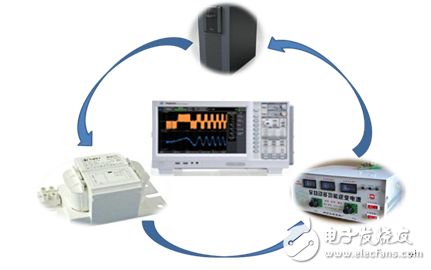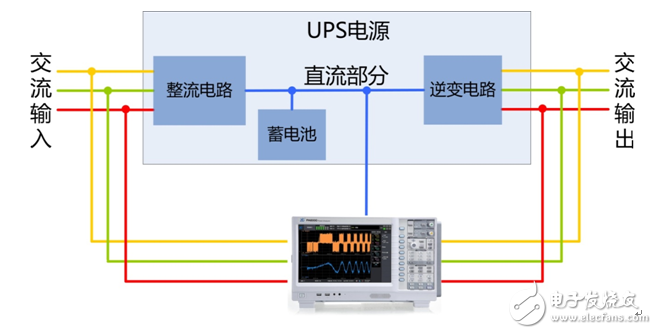Abstract: Recently, customers who have made inverters consulted with power factor measurement. The customer wants to know what kind of load factor the inverter's power factor should be measured under, and resistive? Capacitance? Still emotional? In fact, there is a big misunderstanding inside, and ignoring such misunderstandings will lead to serious differences between manufacturers and manufacturers of inverters.

First, the definition of power factor
The alternating current voltage and current on the purely resistive load are in phase, that is, the phase difference q = 0°, as shown in the left figure of Figure 1; the voltage and current relationship of the alternating current on the pure capacitive load is the current lead voltage 90 ° (q = 90 °), as shown in the figure in Figure 1; the voltage and current relationship of the alternating current on the purely inductive load is the current hysteresis voltage of 90 ° (q = -90 °), as shown in the right figure of Figure 1.

Figure 1 voltage and current relationship
The active power on the resistive load is the apparent power, ie the two are equal, so the power factor λ=1. The current and voltage on pure capacitors and purely inductive loads are 90° out of phase, so the power factor λ = cos90° = 0, ie the active power on pure capacitors and purely inductive loads is zero.
From here, we can see a problem, the same is a power supply, the magnitude and nature of the output power of the load for different properties are different, so it can be said that the nature of the load determines the output of the power supply. In other words, the output of the power supply does not depend on the power supply itself, just like the water supply flow of a water tower depends on the degree of opening of the faucet, Figure 2

Figure 2 Water tower and faucet
As can be seen from the discussion above, the power factor is a parameter that characterizes the nature and size of the load. And generally speaking, a load has only one nature, just like a person has only one ID number. This property is determined by the input of the load, called the input power factor of the load. Once a load circuit is completed, its input power factor is fixed.
For example, the UPS is used as the load of the front mains or generator. For example, the UPS of a six-pulse rectified input has an input power factor of 0.8. Whether it is a mains grid or a generator, for example, an input power of 100 kVA is required. Request 80kW of active power and 60kvar of reactive power to the front power supply. If the input power factor of the UPS is 0.6, you need to request 60kW of active power and 80kvar of reactive power from the front power supply. For output distribution like this, the front power supply is determined by "no power".
Second, the parameters that characterize the UPS output capability - load power factor
As we all know, the shoes that people wore long ago were made one-on-one by tailors according to the size of each person. In modern times, due to the development and division of labor, many industries have emerged. For example, the shoe industry needs to make a lot of shoes in advance for the needs of the society. The question is how big shoes are? This requires a plan in advance. This plan comes from the social crowd. How big is the foot of most people, so we develop various sizes, that is, how many yards. The same is true for UPS. It is not always possible to manufacture one-to-one. It is also necessary to pre-manufacture a batch or batch of machines with different power factor and power specifications according to the form and scale of the current electrical appliances, in case of spot market sales. The basis for pre-manufacturing one or several batches of UPS is the load power factor. When the load power factor of the UPS is equal to the input power factor of the load, it is called perfect match, and the UPS can output the full power. Figure 3 shows the UPS load power factor versus load input power factor.

Figure 3 UPS load power factor and output power factor
Third, the misunderstanding of power factor
It is precisely because some users mistake the load power factor for the "output power factor" of the device, which not only misplaces the attribution relationship, but also leads to a concept that does not exist at all. Since it is the "output power factor of the device", the output power of the device must obey this power factor value, that is, "100kVA devices with a power factor of 0.8 should also give an output power of 80kW when with a linear load." If this misunderstanding is only for individual users, it will lead to conflicts between users and suppliers. But if the standard is caught in this misunderstanding, the hazard is the national equipment manufacturer. The input power factor and load power factor of various types of power equipment (such as UPS, inverter, rectifier, etc.) can be measured simultaneously using the PA8000 power analyzer of Zhiyuan Electronics. Avoid misunderstandings happen again, as shown in Figure 4.

Figure 4 Using the PA8000 to measure the power factor of the UPS power supply
Medical Cart & Cabinet series including all types of medical cart and cabinet, which are widely use at hospital or beauty salons.
Medical Tools Cart,Bedside Metal Counter,Medical Metal Cabinet,Hospital Metal Chest
Foshan Dinghan Electrical Technology Co., Ltd , https://www.dinghanelectrical.com